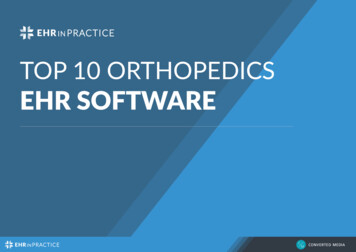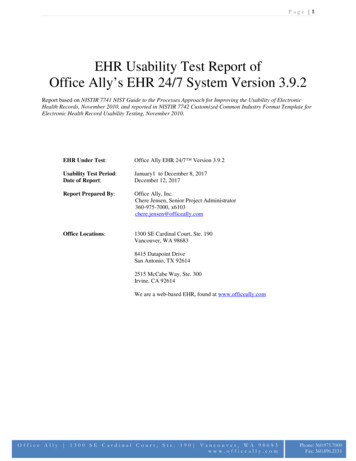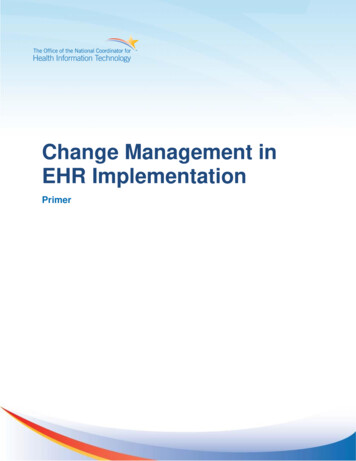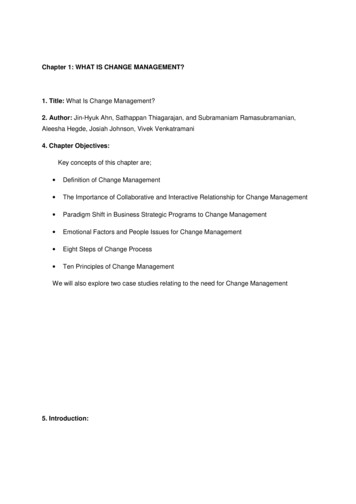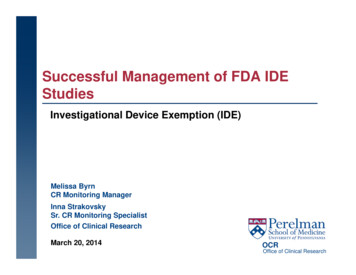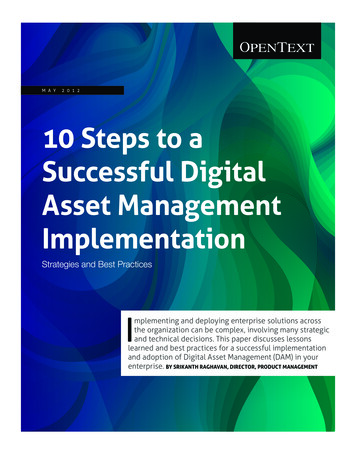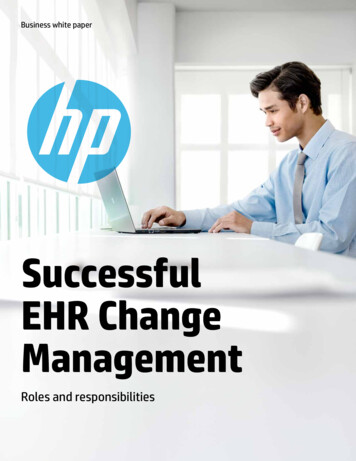
Transcription
Business white paperSuccessfulEHR ChangeManagementRoles and responsibilities
Table of contents3Achieve the benefits of EHR3Never underestimate the power of the people4People4From resisting to embracing change6Roles6The importance of defining every part to be played7Responsibilities7The need to spell out expectations for everyone8Keep people at the center8About HP for healthcare8For more information
Achieve the benefits of EHRImplementing a new electronic health records (EHR) system is a bigchange for your practice. Successful management of that changeinvolves thinking not only about the new technology, but also aboutyour people. They have tremendous power to influence the successof your EHR rollout. To use that power to your advantage, you needto understand how the change will affect them, how best to engagethem in the process and how to tap into their experience to design thebest outcome. The more effectively you can do that, the faster yourpractice can start to realize the many benefits of electronic records.HP is here to help, by providing a walkthrough of the assessment,documentation and goal-setting involved in getting there.Never underestimate the power of the peopleMany medical practices today are preparing for one of the mostsignificant technology implementations they will ever see. Thewidespread shift to electronic health records (EHR), spurred byfederal financial incentives for technology adoption (see Figure1), virtually guarantees that every medical practice in the countrythat hasn’t already adopted an EHR system will now be consideringit more seriously than ever. Meeting meaningful use objectivescould mean reimbursements of up to 63,750 per physician. A keyfactor in whether a practice succeeds is how well it manages thistremendous change in the way care will be delivered. That changeinvolves not just the technology the practice will use, but also – andperhaps more importantly – the people who will use it. They havetremendous power to influence its success.Technology is just part of the picture (and not necessarilythe biggest part)It’s easy to see EHR adoption as mainly a software issue, but that’sonly a small part of the picture. To be sure, technology is a centralcomponent in the shift to electronic records; as discussed in the HPwhite paper “Four EHR Change Management Mistakes,” choosingthe right EHR technology for the practice is an important element ineffecting change successfully. But once a practice has determinedits IT readiness, and planned the technology transition accordingly,critical non-technology considerations come into play. Theserange from making sure that people in the practice understandand support the coming change to making sure the right team is inplace. Without the active support of the people who will be using thetechnology, and be affected by it on a daily basis, even the bestplanned technology implementation may not succeed.Figure 1The EHR incentive program in briefWhatA program of financial incentives for adopting EHR; a component of the HITECH Act, which is part of the American Recovery and Reinvestment Act(ARRA) passed in 2008WhoAvailable to healthcare providers including hospitals and medical practicesWhereNationwide, with incentives for Medicare providers administered by the federal government and incentives for Medicaid providers administeredthrough individual states’ Medicaid programsWhen2011 is earliest year in which providers can participate; Medicare track runs through 2016 and Medicaid track through 2021WhyTo encourage providers to adopt EHR technology, which can help to improve patient health and the way health care is deliveredLearn more at cms.gov3
PeopleFrom resisting to embracing changePeruse the definitions of “change management” on the web,and you’ll quickly see the importance of people in the process ofsuccessfully managing change. While many definitions describechange management in terms of organizational change, they generallyalso include references to individual change. For example, accordingto one source, the Government Accounting Office defines changemanagement in part as building consensus among people on change.1The Change Management Learning Center describes it as “the process,tools and techniques to manage the people-side of business change.”2The Health Information and Management Systems Society (HIMSS)talks about EHR change management in particular as “the human sideof electronic medical records implementations, the human-focusedwork of engaging and preparing people to succeed in the new world ofEMRs.”3 So while change management happens at the organizationlevel, it’s not just about the organization as a whole; it’s about theindividuals that make up the organization. It’s about people.The benefits of a people-centered approach toEHR change managementMedical practices that manage the change to EHR successfully –which is to say, by taking into account not only the technology,but also the people involved – can realize many benefits. Makingsure everyone is on board with the plan, the right team is in placeand the team members understand their roles will go a long waytoward minimizing any potential disruption that such a majorIT implementation can bring. Once the new system is in place,successful change management can also help to ensure that peoplewill start using the system productively as soon as possible. Andthe more quickly that happens, the closer the practice will be toseeing the operational, clinical and administrative benefits that arethe ultimate promise of EHR. This paper is designed to help medicalpractices that are adopting EHR to manage the change, specificallyby providing information about engaging people in the process,defining their roles and assigning clear responsibilities to them,all in the interest of a successful transition.4One of the reasons people are such an important focus in changemanagement is that they can strongly influence how successfully anorganization changes. For example, just because you implement anEHR system does not guarantee that you will derive the maximumbenefit from it. The people who are going to use it and be affectedby it, from staff to patients, ultimately determine how successfulthe implementation will be. If, for example, office staff membersrefuse to use it, or don’t get the training they need to use it properly,the benefit will be minimal at best. This perhaps explains why theCollege of Healthcare Information Management Executives (CHIME)and the Health Research and Educational Trust (HRET) recentlyconcluded that “training in advance of using a new EHR system andtangible support for the implementation in its first days and weeksof use are critical success factors for facilitating the deployment.”4
Establishing clear roles and well-defined responsibilities is animportant step to help ensure that people are prepared to deal witha planned change such as an EHR implementation. This imposesvaluable structure, sets appropriate expectations and makes changemore manageable for people. And it will be critical to your practice’ssuccess in moving as efficiently as possible through the spectrum oftypical responses to change, from resistance to acceptance.Moving across the spectrum of responses to changeAs HIMSS points out, EHR change management involves dealing withthe human aspects of the project through behavior change, “by helpingpeople understand and internalize change and by preparing them to besuccessful contributors in the future state.”3 The idea is to move peoplethrough the process of change, as quickly as possible, to achieve thegreatest benefit from the project as quickly as possible. The first step isto recognize where people are in the range of responses to change.Resistance: It’s human nature to resist change. That can be particularlytrue in professional environments where change may threaten todisturb familiar routines, and where technology change in particularcan undermine people’s confidence in their own skills and knowledge.In-Between: Even if people are relatively comfortable with the shiftto an EHR system, they may still have fears about how well theywill do with the new technology. They may worry that they’ll be lessproductive than they were before the change or that they’ll makemistakes that result in important patient data being lost – and thatproblems like these will reflect poorly on them.Acceptance: The goal is to get people to the point where they feelconfident about their abilities with the new system, and they beginto see the benefits of being more effective and productive. At thisstage, they can also be an excellent resource for helping others whoare not so far along.Easing the transition from resistance to acceptanceThe next step is to take specific actions to move people along thepath from resisting change to actively embracing it. There areseveral things you can do in this effort:Assess the readiness of staff members to make the transition. Asan implementation guide from the HIMSS points out, “part of theproblem encountered during transition is that change is messy:people start where they are, not where we want them to be.”4 CHIMEand HRET’s guide recommends conducting a readiness assessmentthat addresses everything from staff knowledge and understandingof issues, to current computer-skill levels.4 Assessing readinessenables your practice to identify a starting point for change thattakes everyone’s situation into account.Adapt to current levels of competency and readiness by creatingtraining plans that are appropriate to them. This is likely to meandifferent training for different groups. For example, an office managerwho uses office software every day may need less keyboard trainingthan a clinician who is accustomed to writing prescriptions andupdating patient charts by hand. Regardless of where staff membersare in their development of skills for using an EHR system, they willneed training not just in preparation for the implementation, butduring and after it. People may not retain everything they learn inpre-implementation training; in addition, as they put what they learninto practice, they may benefit from more advanced training.Document current workflows to determine what’s currently workingfor people and what isn’t, before the EHR implementation begins.Keeping the focus on people, HIMSS recommends having thepeople involved in each clinical workflow map it out, with the goalof streamlining and identifying new workflow processes.5 Onceworkflows are documented, get feedback from the people who areinvolved in them about how they could be improved. Change them,test them against various clinical scenarios, and adjust workflows –and implementation plans – accordingly. The point here is that simplyautomating recordkeeping processes won’t help if they are flawed tobegin with. Even the most advanced EHR system can’t perform to itsfull potential if it’s being applied to processes that don’t work.Set goals for the entire project that reflect the needs of everyonewho will be affected by the change. This will foster a sense ofachievement among participants as they see their own contributionsto meeting the goals. Goals should be specific, rather than general,to help ensure that they are achievable. For example, “increasebilling by x% through more accurate coding” is preferable to“improve billing.” It’s difficult, if not impossible, to tell when thelatter has been achieved. But people will have a clear marker for theformer – one that they can celebrate and take pride in achieving.5
RolesThe importance of defining every part to be playedManaging the change associated with an EHR implementation requiresa solid understanding of how the individuals within a medical practicefit into the process. Everyone in the practice has a part to play, fromdriving change, to implementing it, to ultimately benefiting from it.The following explains the key roles in the process of EHR changemanagement and the individuals associated with them. Practice sizewill, of course, affect who fills what role, and we have made a point oftaking this into account in the following discussion.DriversThese are the people who drive change from the top – makingthe decision to implement an EHR system, setting the goals forthe implementation and ultimately taking responsibility for itssuccess or failure. In a small practice, there may be one driver – thephysician who operates the practice. In larger organizations, it caninclude multiple physicians, clinical leadership and office managers.The largest practices may even have a steering committee that isresponsible for overseeing the project; this committee may includea physician, a nurse, an IT professional from within the practice andperhaps an external expert such as a hardware vendor.Drivers set the tone for an EHR project from the top, and from thestart. By demonstrating a strong commitment to and confidence inthe project, they can play a huge part in getting staff buy-in for theeffort. By the same token, by not doing so, they can derail it. It’s evenbeen specifically suggested that these leaders make a special point ofbeing highly visible and engaged during the first two (often difficult)weeks of actual implementation,6 when people may be particularlyfrustrated as they work to adapt to new ways of doing things.ImplementersThese are the people who make change happen – implementingthe software, carrying out the hardware refresh and providing thetraining and post-implementation support that will be needed tohelp ensure the project’s success. Their efforts are led by a projectmanager whose role it is to keep the project on track and makesure it fulfills the goals of the practice as defined by the drivers. Ina larger practice, the project manager may be an IT professionalor office manager, working in close coordination with the softwareand hardware vendors who are providing the technology. In asmaller practice, or in any practice where the IT professional oroffice manager are not in a position to take on major additionalresponsibilities, the project management role may be primarily filledby someone outside the practice, such as an independent technologyconsultant or EHR vendor.6The project manager leads a project implementation team thatconsists of both the vendor who is installing the implementationand internal people who represent the practice roles that will beaffected. The number of the latter will depend on the size of thepractice. In almost any size practice, however, it is always valuableto identify a “super-user” to be on this team. This is someone whotakes a special interest in the project, either because of an existinginterest in EHR or in IT in general. This person can play a valuablepart in troubleshooting by communicating with vendors about anyimplementation issues that may come up. If time permits and thesuper-user is willing to accept the responsibility, he or she may alsotake on the role of vendor coordinator, communicating with vendorsregularly and keeping the practice apprised of progress.ChampionsThese are the people who “cheerlead” the practice through an EHRimplementation – actively supporting the shift to EHR, conveying itsbenefits to their peers and having an overall positive influence on theway the practice deals with the transition. They may not necessarilybe the powerful drivers of change who make the big decisions –although in a small practice, they might very well be one and thesame. In either case, they are well-regarded members of the team.Champions may be clinicians, or they may be members of the officestaff. In a large practice with a significant non-clinical component,office staff management at the supervisor or middle-manager levelmay play this role. The point is that they are people to whom clinicaland office staff member look for guidance and direction, and theiropinions matter. They can play a key role in conveying the benefitsof change to others in the practice. For this reason, you should solicittheir input into designing new workflow processes and providingsupport to other employees. The drivers and leaders of EHRinitiatives should take their concerns seriously and communicatewith them on a regular basis.BeneficiariesThese are the people who benefit from a well-managed EHRimplementation – and ultimately, that includes just about everyoneaffected by it, both within and beyond the practice. Here’s how.Physician-owners benefit as principals in the practice from thepotential for significantly reduced operational costs and higherproductivity. For example, automation can speed recordkeeping andother tasks, allowing physicians to see more patients in the sameamount of time without compromising their care. Other operationalsavings may come from eliminating the need to store paper records,eliminating costly transcription requirements and reducing thecosts of HIPAA requirements and other mandates by organizinginformation more effectively for auditing purposes.
Physicians and clinicians benefit from improved clinical decisionmaking. As the Department of Health and Human Services explains,“The data, and the timeliness and availability of it, will enableproviders to make better decisions and provide better care.”8Physicians, nurses and others who provide care will have betteraccess to patient information, and therefore better resources withwhich to make clinical decisions.CliniciansOffice staff benefits from being relieved of manual administrativetasks such as sending out patient appointment reminders,scheduling office visits and obtaining patient information in advanceof an appointment. EHR systems also completely eliminate the needto perform tasks such as re-entering data from handwritten notes.Office staff should also find it easier to retrieve electronic chartsthan paper records, by using a simple computer interface rather thansearching through physical files.Office ManagerPatients benefit from better care that comes with accurate, clearmedical records. The New England Journal of Medicine suggests that“there are numerous ways in which EHRs can diminish diagnosticerrors,”9 for example, because information is continuously updated,helping to ensure current and accurate records at all times. Thisimmediate access to information also benefits patients becausethey are less likely to be subjected to unnecessary testing or delayedtreatment that can occur when physicians don’t have access tocurrent testing or treatment history. Help manage system trainingOutside entities like pharmacies and payors benefit from being ableto share information with medical practices more quickly, accuratelyand with enhanced security.Responsibilities Evaluate clinical workflows and recommend changes Validate future clinical workflow descriptions Assess software’s clinical usability Potential: Champion the project among staff Potential: Coordinate with vendor for troubleshooting Evaluate day-to-day usability of EHR software Oversee integration with legacy technology Oversee integration with complementary software, e.g.back-office applications Manage transition from paper to digital records Identify data conversion and reporting needs Potential: Serve as project manager Potential: Champion the project among staff Potential: Coordinate with vendor for troubleshootingFront Office Staff Utilize and test critical functions such as scheduling Document any incompatibilities or glitches in daily functions Day-to-day transition from legacy paper records into EHR data Document patient insurance authorizations Data entry for billing and coding Confirm data exchange with pharmacies and other thirdparty vendorsThe need to spell out expectations for everyoneIT ProfessionalWhat exactly are the responsibilities that each person in a practiceneeds to fulfill to help make the transition to EHR successful? Itcan vary depending on practice type and size, but the following willgenerally apply. Assess software and hardware needsPhysicians Potential: Serve
component in the shift to electronic records; as discussed in the HP white paper “Four EHR Change Management Mistakes,” choosing the right EHR technology for the practice is an important element in effecting change successfully. But once a practice has determined its IT read
